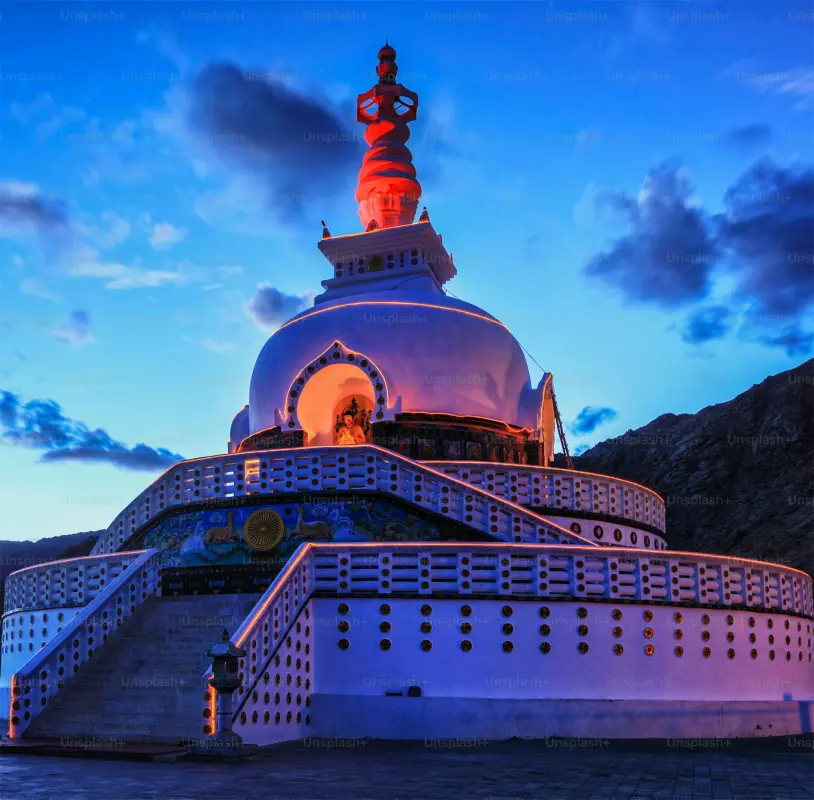Himalayas: The Majestic Abode of Snow and Spiritual Grandeur
Introduction
This grand mountain chain stretches through five nations—India, Nepal, Bhutan, China, and Pakistan. It stands as the world’s tallest mountain system and holds immense significance for the development of human civilization.
The Himalayas are home to the world's highest peak, Mount Everest (8,849 m) as well as many other towering peaks. Several great rivers, including the Ganges, Yamuna, Brahmaputra, and Indus, originate in the Himalayas and sustain the lives of millions across South Asia.
Apart from geography, the Himalayas also have profound spiritual, cultural, and ecological significance. Ancient sages meditated here, they find mention in great epics like the Mahabharata, and its valleys are home to thousands of temples and monasteries.
Fun Fact: Did you know that the Himalayas are still growing by about 5 mm every year due to tectonic movements?
Whether you are a traveler, a spiritual seeker, or a lover of natural wonders, the Himalayas are a symbol of majesty, divinity, and resilience.
Geographical Location and Map
- Countries Included: India, Nepal, Bhutan, China (Tibet), Pakistan
- Indian States: Jammu & Kashmir, Himachal Pradesh, Uttarakhand, Sikkim, Arunachal Pradesh
- District Examples: Dehradun (Uttarakhand), Kangra (Himachal Pradesh), Leh (Ladakh), Darjeeling (West Bengal)
- Major Landmarks: Mount Everest (Nepal-China Border), Mount Kailash (Tibet), Nanda Devi (Uttarakhand, India)
📍 Click here – View Himalayas on Google Maps
History and Background
Origin and Beginning
Around 50 million years ago, the collision between the Indian tectonic plate and the Eurasian plate gave rise to the Himalayas. This geological phenomenon continues to this day, which explains the frequent occurrence of earthquakes and landslides across the Himalayan belt.
Formation Timeline (Natural Formation)
Unlike monuments built by rulers, the Himalayas are the result of millions of years of natural formation. During the Tertiary period, sediments at the bottom of the ancient Tethys Sea were pushed upward, forming these massive mountains.
Historical Events and Stories
- Ancient texts like the Rig Veda and the Puranas describe the Himalayas as the abode of the gods.
- Great personalities like Adi Shankaracharya, Buddha, and many sages meditated here.
- The Himalayas provided India with natural protection from invasions in ancient times.
Legends and Myths
Mythological texts of Hinduism portray Mount Kailash in the Himalayas as a sacred peak, honored as the celestial home of Lord Shiva along with Goddess Parvati.
It is also believed that the Pandavas of Mahabharata went to heaven through the Himalayas.
Architecture and Design
Architectural Style (Natural Divisions)
- Trans-Himalayas: Northernmost zone, includes Karakoram and Ladakh ranges.
- Greater Himalayas (Himadri): Contains tallest peaks like Everest, Kanchenjunga, Nanda Devi.
- Lesser Himalayas (Himachal): Known for Shimla, Mussoorie, Nainital.
- Shivalik Hills: Outermost range with dense forests and wildlife sanctuaries.
Materials and Techniques
The Himalayas are made up of igneous, sedimentary, and metamorphic rocks. Glaciers serve as natural reservoirs.
Gardens and Environment
Lush valleys like Kashmir, Kangra, and Kathmandu and meadows like Gulmarg and Valley of Flowers enrich the Himalayas.
Artistic Elements
Among the holiest pilgrimages in Hinduism is the Char Dham Yatra, which takes devotees across Badrinath, Kedarnath, Yamunotri, and Gangotri.
Cultural and Spiritual Significance
Religious/Spiritual Significance
- Mount Kailash – abode of Lord Shiva.
- Amarnath Cave – famous for naturally formed ice Shivling.
- Char Dham – sacred sites of Badrinath, Kedarnath, Yamunotri, and Gangotri.
- Lumbini (Nepal) – birthplace of Lord Buddha.
Cultural Relevance
The Himalayas have been glorified in Sanskrit poetry, Puranas, and folk songs, inspiring countless festivals, rituals, and pilgrimages.
Influence on Art and Literature
From the poems of Kalidasa to modern Bollywood films, the Himalayas remain an eternal inspiration.
Travel Information
Location and Access
The Himalayas stretch for more than 2,400 kilometres across Asia. In India, it covers Jammu & Kashmir, Himachal Pradesh, Uttarakhand, Sikkim, and Arunachal Pradesh.
- Air: Dehradun, Leh, Kathmandu, Paro.
- Rail: Haridwar, Jammu, Kalka (foothill stations).
- Road: National Highways and scenic Himalayan routes.
Tickets and Entry
Visiting the Himalayas is generally free, though protected areas like Valley of Flowers, Kaziranga, and Everest Base Camp require permits and fees.
Nearby Attractions
- Kashmir Valley
- Leh-Ladakh
- Manali and Shimla
- Darjeeling and Sikkim
- Bhutanese Monasteries

Kashmir Valley

Leh Ladakh

Manali & Shimla

Darjeeling & Sikkim

Bhutanese Monasteries
Travel Tips and Recommendations
Travel Advice
Best time: April–June (summer) & September–November (autumn). Winters (Dec–Feb) bring heavy snowfall.
Local Experiences
- Try Thukpa, Momos, Butter Tea.
- Stay at local homestays in Himachal and Sikkim.
- Attend Tibetan festivals in Ladakh and Bhutan.
Tips for Tourists
- Carry warm clothes and oxygen cylinders.
- Respect local customs and monasteries.
- Avoid plastic and be eco-friendly.
Fun Facts and Trivia
- The Himalayas host 9 of the world’s 10 tallest mountains.
- The Ganges, Indus, and Brahmaputra rivers originate here.
- The Himalayas shape India’s climate by blocking cold winds and bringing monsoons.
- Everest is called “Sagarmatha” in Nepal and “Chomolungma” in Tibet.
Impact and Legacy
Global Recognition
UNESCO recognizes sites like Nanda Devi National Park and Sagarmatha National Park as World Heritage Sites.

Nanda Devi National Park (Uttarakhand, India)

Sagarmatha National Park (Nepal)
Influence on Modern Architecture
The natural fortress-like structure of the Himalayas has inspired designs of Indian forts and temples.
Heritage and Conservation
Threats from climate change, deforestation, and tourism pressure are rising. Conservation efforts focus on glaciers and biodiversity.
Conclusion
The Himalayas are not just mountains—they are living guardians of nature, culture, and spirituality. They shelter sacred shrines, nourish rivers, inspire poets, and challenge adventurers. A trip to the Himalayas is both a journey through landscapes and through history, mythology, and endurance.
If you ever dream of experiencing the true grandeur of nature, the Himalayas should be at the top of your travel list.

.webp)



